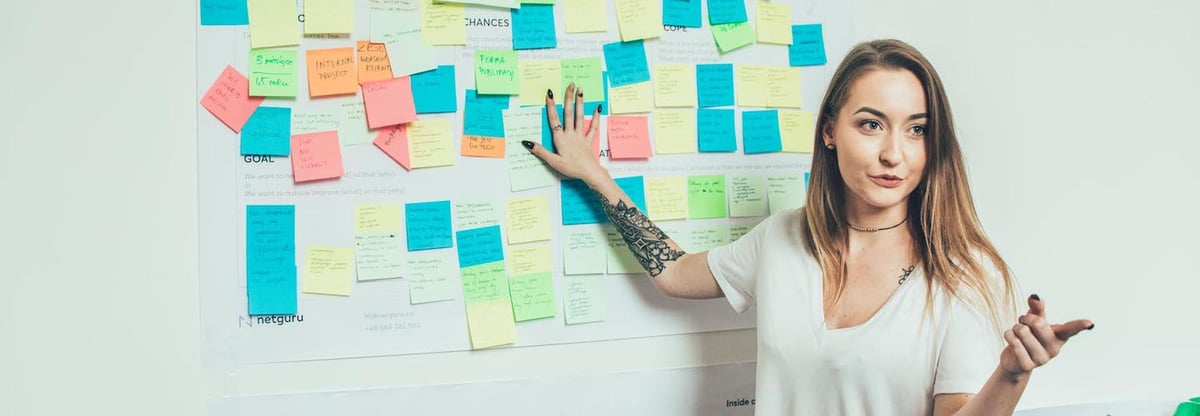Product Design Sprint – Examples of the Workshops

They need to be more agile and flexible, spot market opportunities or pain points early and take advantage of them before the competition does. In other words, they need a good process for leveraging new information and ideas to benefit their business.
The Product Design Sprint, a five-day discovery workshop, is exactly the tool they’re looking for. Let’s take a look at a few case studies to see why this is true.
Automotive customer service process – Volkswagen Home
Holding the title of the world’s largest automotive manufacturer by sales as of 2018, Volkswagen hardly needs an introduction.
Always striving to stay on top of market news, the company consulted a report from a global management consulting firm, based on about a million interviews with customers who bought a car in the last ten years.
- The results revealed a clear risk to sales: only 10% of customers who were happy with their car but not the customer service they received during the purchase thought they’d buy from the company again.
- This risk translated directly into an opportunity: 25% of customers who weren’t completely satisfied with their car but enjoyed a delightful experience from the company’s representatives said they would remain loyal to the brand.
In other words, customer service much more important than the quality of a car in terms of its impact on sales. Volkswagen chose to capitalise on and test this theory by designing a unique, luxurious experience for their aspiring middle-class customers.
This pioneering approach came with a long list of challenges. The EU’s legal restrictions make it so that car importers cannot sell directly to customers.
This compelled Volkswagen to pitch their idea to their dealer network and win their hearts. The events of this story happen in Warsaw, Poland, where dealerships are located mainly on the outskirts of the city, requiring an inconvenient trip for most city-dwellers. The city centre wouldn’t have been much better, though, so a middle-ground location with convenient access needed to be chosen.
Once these issues were settled, the challenge of designing an extremely friendly and transparent customer service (one involving multiple stakeholders) remained open. It was also the first initiative of its kind, requiring a new approach from Volkswagen, which meant deviating from the standard practice and cooperation between business units that would normally go separately.
Method
Netguru’s involvement in the project, called Volkswagen Home, began with research, review and a 3-day workshop with the client’s team, based on the design sprint methodology. The research stage involved an in-depth analysis of the report mentioned above.
This helped us prepare for the workshop. Next, together with the client, we analysed the automotive sales funnel, deconstructing it to see each of the parts for what it was.
The workshop allowed us to identify all stakeholders and potential backers, then define the required employee positions and tasks. We went all out to design every possible customer interaction that could occur, from the arrival at Volkswagen’s parking lot to serving coffee, and, finally, saying goodbye. We also defined the process of cooperating with car dealerships.
To help the client step away from their routine, we showed them ours. We workshopped collaborating with different business units and engaging stakeholders, using the agile principles and managing an agile process (including daily standups, project sprints and using MVPs), and effective communication between decision-makers within a fully remote team.
Outcome
Volkswagen Home opened at the end of October 2017, and customers loved it. They felt catered to and valued, which helped them deemphasise price during the purchase process.
- In the first two months, we saw twenty closed deals – all without an awareness campaign.
- The average sale price at VW Home was EUR 900-1200 higher than the price in traditional dealerships.
- 50% of customers chose pricier cars with a better direct-shift gearbox (DSG) – and the market average for this is 25% of customers.
Based on an initial version of the “Volkswagen Home Bible”, the company can use the results of the design workshop we ran to continue developing the project and to launch new ones.
Growing a company by 644% in 3 years – Netguru
Work at Netguru is fast-paced and challenging, yet well-organised. Several project teams cooperate with different clients at the same time.
Many of these clients speak a different language and operate under a different timezone. The sales and recruitment teams need to balance available manpower with new business constantly. This both facilitates and limits growth. After witnessing our clients reap the benefits of running a Product Design Sprint, we decided to apply this tool to our own situation.
The goal was to find a way to deliver a greater number of quality products while maintaining trust with our clients and high quality of service. We built an eight-person workshop team with representatives from the Marketing, Business Development and Design Departments. Looking at our internal process from several different perspectives was both a challenge and an advantage.
Method
Our Design Sprint involves a number of exercises aimed at identifying our strengths and weaknesses. We built client personas and customer journey maps, which helped us understand clients’ goals and expectations better. We interviewed employees who interacted with clients directly and took advantage of their experiences to create better value propositions.
Using the Design Studio methodology, we came up with a shared vision for how we want clients to view Netguru.
Outcome
The PDS allowed us to improve our strategy based on our vision and the nature of our market. We managed to:
- Reach 63 on NPS (the industry average varies between 28 for software and apps, and 41 for software services, depending on the source; in 2018, Google had an NPS of 53);
- Make our website easier to navigate, lowering bounce rate;
- Attract hundreds of attendees to events held at our HQ;
- Enhance our recruitment pipeline;
- Release our own products (Callio, CarLens, Pockee);
- Gain international recognition with one of our design concepts;
- Build a more trusting relationship with clients.
Facing an NGO’s challenges – Pure Earth
Pure Earth, an international non-profit based in New York, aims to manage toxic pollution across the globe.
They’ve been helping overcome pollution in low- and mid-income countries over the last two decades. They produce the World’s Worst Pollution Problems annual reports and assess pollution at over 3,000 sites in more than 60 countries for the Toxic Sites Identification Program database. The PDS we ran together with them was aimed at reducing risk, defining clear goals and updating their strategy during a short workshop.
Method
Because Pure Earth is a global organisation, we had participants from three time zones joining us remotely. This was a big challenge, as one of the main goals of the PDS is to build a foundation for better relationships and collaboration between teams.
We made sure to break away from the ruthlessly professional standards of online meetings and focused on heartfelt human interaction, using a few exercises to break the ice. This set the right tone for the rest of the workshop.
We used the standard PDS framework to define a clear role for each participant, and leveraged the tools we had, establishing an orderly emailing procedure, using Google Meet and its inbuilt chat for video calls (screen sharing when needed), and chose mural.co for our virtual workspace. Limiting ourselves to these three tools helped us communicate without noise and achieve our goals more effectively.
Outcome
Together with Pure Earth, we’re building an app that will raise awareness about pollution and its effects. By documenting examples of pollution, the app will also become a platform for underrepresented communities and help them inspire others to take action.
We’re building accessible UX and UI to accommodate users from around the world. Thanks to a good process including a PDS, we’ve already established an effective visual language for the project, one that will help the brand communicate its message.
Overcoming deadlocks with a modified design sprint – anonymous client
Product Design Sprints can be used with a very specific goal in mind, or to solve specific challenges. One of our projects presented a number of complications which we chose to solve with a PDS.
- The client could only spend an hour a day, remotely, with us.
- They wanted solutions quickly, and trusted that we deliver them in the best possible way. They were also open to advice on their business and strategy.
- While our relationship with the client was great, the time constraints on their part meant very little feedback for us and, as a result, a deadlocked project.
To overcome this challenge, we built a variant of a typical PDS team. It included the Product Owner (the product designer who worked on the project), a new product designer with an outside perspective, and the project manager as a coordinator. The client assisted us by becoming a remote tester to validate our team’s ideas.
Method
- First, we had to help the new Product Designer understand the scope of the project byanalysing the competition, UX and strategy. Tools such as a Project Card or a map of stakeholders were very helpful at this stage.
- We started setting up our first wireframes on the second day. We analysed the basic User Flow to focus on the project’s core features.
- The client approved the solution we came up with and gave us valuable feedback, and on day three, we adjusted the mockups and prototype.
More testing and iterations were needed, so we expanded the team with another Product Designer to speed things up.
Outcome
The results of the PDS were valuable. We found the project’s weak points and improved our initial ideas. This allowed us to set better priorities for the project team, making their work more efficient and pushing the project forward. Importantly, we proved to ourselves that the PDS can be a versatile tool, useful in many circumstances.
Running a PDS to help a city with community challenges – Warsaw
The City of Warsaw has 1.7 million residents and an infinite amount of public data.
This data, if made available to all, could empower citizens and small businesses, improving lives in the metropolis. Warsaw joined the open data movement and began encouraging organisations to follow suit, but a number of challenges lay ahead – mainly, that they had accumulated an incredible amount of data, which was both a great opportunity and a challenge.
Public data is scattered and difficult to access. It’s stored and updated with various tools and methods, creating a dispersed system with many redundancies and a lack of policies for coordinating future data collection.
Not being aware of the benefits that a unified data network brings results in low interest in building one. Netguru offered to join forces with city representatives and NGO workers to run a PDS that would result in an operational strategy for organising and sharing public data. The team also wanted to prepare a concept of a digital product that would both solve real residents’ problems and attract them to the idea of leveraging the data themselves.
Method
The workshop involved brainstorming sessions, as well as specifying goals and parameters based on residents’ needs. Data was examined based on a number of factors, such as availability, interdisciplinarity, scalability, interactivity and feasibility. The team considered budgetary and time constraints, hoping to choose the idea for a project that would be feasible and could help many stakeholders.
Outcome
Three ideas made it to the final round, and were evaluated based on previously established parameters. A project evaluating the quality of life in distinct areas of Warsaw (including such factors as transportation, noise levels and healthcare accessibility) was the winner. The city is on its way to bringing it to life.
The benefits of a failed Design Sprint – WeWork
As remote work and co-working spaces have gained in popularity, providers of such spaces have experienced rapid growth and are constantly looking for new opportunities.
WeWork looked into new monetisation paths to match the competition’s wider offer, and used a design sprint to complete the project in only a month. The idea was to add on-demand booking and benefit from the revenue potential of unused space, without interfering with the experience of the core users under the membership model.
Method
Testing a concept quickly isn’t easy for a massive, fast-growing, global team. WeWork collaborated with a technological partner over a 4-day design sprint, then followed it up with a week-long iteration sprint, and finally, development.
The team, which included marketing, product and technical talent, went through the actual booking process to familiarise themselves with the experience. They chose to test rebooking (booking for a second time) as their sprint goal. They went from user flow to storyboards to the final prototype, then went to real users for feedback. The follow-up sprint helped them polish their prototype and goals.
Outcome
They did everything right, and yet, the WeWork team hit the breaks on the project, benching it for the foreseeable future. While this might sound like a bleak ending to a well-executed project, it’s actually the opposite. WeWork invested very little time and resources in the project, and were able to execute a successful pivot, avoiding potentially significant losses.
Attracting larger customers – Slack
Slack, one of the most popular team communication tools in the world, is an integral part of everyday operations at Netguru and many other companies.
It might surprise you to learn that Slack began as an internal tool for a video game development company. Seeing the tool’s potential as it was adopted by tech startups (more than 60,000 teams in their first year!), Slack’s creators needed a way to explain the value of their tool to larger organisations.
Method
Merci Grace, a product manager at Slack, ran a design sprint with the goal of discovering the best methods of communicating Slack’s value proposition.
Design, engineering and marketing talent, along with a few investors, participated in the workshop. It took them three days to identify their problem and come up with a whole list of solutions, such as case studies and animated guides. The results? Slack is the communication tool of choice at companies like IBM, Autodesk and Shopify.
The key benefits of the Product Design Sprint
A well-executed PDS can have varied results depending on the problem it was meant to solve. Volkswagen managed to boost sales by 100%, while building brand loyalty at the same time. WeWork minimised the risk of a new investment and avoided losses, while Slack earned the trust of multinational corporations and market leaders. Netguru experienced astounding growth – by 644% in only three years. Other benefits of running a design sprint include higher ROI, quick validation of ideas and business strategy, and safer innovation.
To achieve all the above, your Design Sprint needs to be conducted with several good practices in mind.
The first major step is to establish good communication and build a relationship based on mutual trust with your Product Design Consulting partner. Thanks to this, you will be able to define the challenges and business goals you want to address during the workshop. These can include:
- Validation of ideas,
- A faster launch,
- Improved business growth,
- Effective prototyping,
And much more. The PDS draws from the lean startup methodology and agile principles, providing tools and frameworks such as user flows, storyboards and A/B tests. It brings focus and purpose to processes that can otherwise become very chaotic and wasteful.
Take a look at the challenges your business is facing right now.
As the examples above clearly show, the PDS can be a fantastic framework for solving even very industry-specific problems. If you’re not sure whether it’s the right approach for you, don’t hesitate to get in touch with us – we’d be happy to help you make the best decision for your company.








